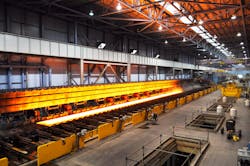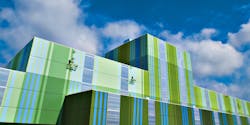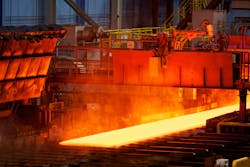After 30 years at steel manufacturer ArcelorMittal, John Cardwell has a big title and the responsibility to go with it, but, “I’m an old mill rat, and I draw on that experience every day,” he says from his temporary home office in Detroit, where family pets occasionally rustle on the other side of the door.
Under Cardwell’s leadership, three ArcelorMittal plants—Indiana Harbor and I/N Tek and Kote facilities in Northwest Indiana, AM/NS Calvert in Alabama and ArcelorMittal Dofasco in Canada—landed GM Supplier Quality Excellence awards this year. Metrics for receiving the awards include low overall quality issues and rejection rates; maintenance of quality certifications, and no plant disruptions or major shipping issues.
Cardwell, ArcelorMittal’s director of automotive sales, oversees voice of the customer for GM, Ford, and FCA, “along with all the supporting Tier Ones and the full supply chain. I really have turnkey responsibility for anything and everything related to those accounts, whether it’s quality, delivery, service, technology.”
A metallurgical engineer by schooling (and then an MBA), “I’ve forgotten more metallurgy than I ever knew,” he jokes. He spent 15 years in the mill on quality control.
"One of the reasons I ended up in this position is because I have that fully supply chain sort of background,” he says. “I did this thing called pre-source. I ran a mill within a mill. Order entry, inspecting steel, delivery to the Asian OEMs, what we call our new domestic business. I would deliver coil overseas in advance of future production, two, three years out, to help qualify our material and get lined up on parts. It was great experience, honestly.”
Cardwell especially relishes his stint managing the finishing department.“I had 150 employeees and loved it,” he says. “I mean, the problem-solving being in the mill every day.” And his more than 10 years spent managing the global account for Toyota, overseeing quality issues. “It was a great experience because I learned a ton about their processes and their methodologies for problem-solving and PDCA.”
Cardwell talked with IndustryWeek about what he brings to his job every day, what went into winning the suppliers awards, and what’s ahead for ArcelorMittal USA on the automotive side of the business.
IW: What were the challenges when you came into this role three years ago?
Cardwell: We want to leverage our technology—whether it’s product development, or what we call co-engineering—to do steel solutions. And even our global footprint—we're unique in North America that we're a global steel company. The only way we can do that is if we have a good foundation of quality, delivery and service. Without that, the whole thing falls apart. So I push the teams, particularly the GM team, to try to focus on that foundation.
Hot strip mill, Calvert, Alabama.
I learned a lot from Toyota. They were very big on the basics. You have to do the basics well, before you can do anything that's more complicated and sophisticated. If you don't pay attention to the basics, everything falls apart.
The good news is a lot of our practices in terms of Failure Mode and Effects Analysis, Plan Do Check Act are corrective actions—supply chain management, working with our outside processors and even our downstream partners. Two of our downstream partners, Tailored Blanks in Ontario and our Dearborn facility also got this supplier quality award.
How did you get buy-in for quality-delivery-service?
I did a visual. Think of it like a pyramid—quality, delivery, service at the foundation. And on top of that, you have technology, which is broken into product development and co-engineering. We have a lot of capabilities to help companies design their vehicles. We know the materials particularly well, formability particularly well. They know how to design vehicles. We marry the two and it works very well.
At the very top of the pyramid is leveraging our global footprint. So, for example, if we have a new product that's made out of Europe that we're going to bring to North America, we don't have to wait till we add that capability in North America; we can use Europe as a bridge. Or even within North America, we can use a different mill as a bridge. And that's very powerful. But again, I come back to, without that foundation, you can't do it.
I also emphasize a couple of key messages. One is, “Quality is a dirty business.” By that I mean, if you turn over the rocks, you find your problems. And when you find your problems, you get your hands dirty, because you have to do a lot of work to solve them. But you have to be willing to turn over the rocks to find the problems. Because if you're not willing to do that, you're never going to get better.
The other one is, “If you make quality, second, it becomes last.” In manufacturing culture, particularly in North America, if you don't make quality your highest priority, it starts cascading down the list of your priorities. You have to keep quality, delivery, service at the top. It’s easier said than done, because you're doing projects on the technology front, you're dealing with contract negotiations, you're doing forecasts. We're doing a lot of things that are very critical to our business, but in the construct of that foundation.
It helps that our account teams are cross-functional. So we'll have a single point person called the global account manager. And then they have their regular commercial director force, but they basically quarterback the entire team, whether it's research, product development, account sales, customer service, etc.
Did you have some leadership training along the way, or did you just kind of learn as you went along?
I go back to my early days as young person working for Chrysler, I spent a year working as a turn supervisor. I was so far in over my head, it wasn't even funny. But because of that kind of stretch environment that I was in, it was sink or swim, and I learned so much about people. Most good, but not all good.
I went back and got my MBA and executive program from Notre Dame and they emphasized a lot about ethical leadership. I've been through some leadership training at the University of Michigan. I, like any leader, have my strengths and weaknesses. I tend to talk more than listen, and that's not good. Something I'm always trying to work on. The company's been good about giving me opportunities to be evaluated, whether it's through 360s or through our leadership training that I did in Europe, to kind of hone skills on an ongoing basis.
Hot dip galvanizing line, exterior.
I've been in the business for over 30 years. With time comes experience and with experience comes skill, including in the leadership realm. I do see myself as a leader; I think that's important. I encourage that among my managers: “Don't just manage, lead.” Managing is checking the boxes and pulling the levers and flying the plane. Leading is deciding: Where are we going to go? How are we going to get there? What are people's strengths? What are their weaknesses, what are our blind spots. And that dovetails well with the quality. If you're not willing to look at where your problems are, you can't identify them. And if you can't identify them, you can't fix them. And if you can't fix them, you can't get better. And if you're not getting better, you're standing still.
Now that you’ve had success with the GM supplier awards, where do you go next?
Quality and delivery in our business, they really reflect one another. The next focus for our team is going to be to try to really work better to integrate those two things. People like to think of them as separate. The truth is, if you have internal quality problems, you may be able to mask them so the customer doesn't see them. But that leads to delivery issues. If you're delivering really well just because you're passing along your problems to your downstream supply chain partners, and eventually your customer, then you're just kind of fooling yourself thinking, “Well, I'm doing well on delivery,” but you really just trading one problem for another.
We've got two other facilities, Burns Harbor (Indiana) and ArcelorMittal Cleveland; they're big suppliers to General Motors and they’re world-class facilities, too. My next goal is to try to get them in the fold. Get them in the mix in terms of winning these awards because they're very capable facilities; we've continued to invest in them; they have a good story to tell. We just need to get their level up to the other assets.
What are the challenges in those facilities?
You have to work to instill the “I can't pass along my problems to the next guy” mindset. And quite frankly, the account teams that we have, while they're cross-functional, they're one step removed from our operations. And the truth is our operations, they have to make it happen. So the big challenge we have is plugging in the account teams and our operations together. As a big company, we have a lot of flexibility, a lot of advantages, but it also brings the disadvantage of it's harder to link operations in manufacturing with quality, with account sales, with finance. We have to integrate those groups. Those are the big challenges to get Burns Harbor and Cleveland to the next level, but also to maintain our level at the assets where we won the award.
How do you improve that? Is it a communication thing?
The big key is making sure that we've got regular, both formal and informal, communication links to leadership. One of the things that's good about ArcelorMittal is that the commercial teams carry a lot of weight culturally within our organization. So my boss speaks for automotive in North America. When he says something, everybody listens, from the manager in the steel shop to the vice president of a particular set of operations. The same thing goes for me as it relates to my accounts of which GM is one. We don't try to abuse that pulpit, but we have that pulpit for that platform.
When you were a Chrysler turnkey supervisor way back when, what were you biggest challenges? It sounds like that was like a turning point in your career.
It was trial by fire. I went from managing one shift a day to running the entire department I was in on an afternoon shift. I was in a transmission plant in Kokomo, Indiana, and the department I was in we had to run 21 turns a week, seven days a week, 24 hours a day to keep up with the transmission assembly lines, which were running basically 12 turns a week two turns six days a week. So by the end of each week, we were really tight on parts. I made drive shafts in my department.
One of the things I learned very early on is it's human nature to load up on the people that work hard for you. And to, for lack of a better phrase, let the people who don't, get away with it. But you have to hold everybody accountable, even if it's uncomfortable. And you have to go the extra mile to thank on a regular basis the people who do work hard and do the heavy lifting. My dad used to say to me, “The” work will find the people who do it. But that doesn't mean that the people who don't should get off the hook just because they're it's ugly and messy and hard.
The other lesson I learned in that experience was “Be honest with people. If you don't know something, say so. If you make a mistake, raise your hand and say, “I messed up.” People respond well to the truth. It creates trust. I learned a lot from my Toyota experience. At Toyota, building trust is key. They work really hard to build trust one-on -one relationships and in business relationships. And I found pretty early in my career that you have to tell the truth even when it hurts. That’s served me pretty well.
Has trade policy affected your side of the business?
No question—the Section 232 had a big impact on our business and the USMCA re-negotiation I think will have a big impact. A lot of people, when they look at the steel industry, assume that all those impacts are good. But there are also some challenges that it causes for our customers. 232 caused them to have to step back and reevaluate their supply chains. Quite frankly, prices went up [initially]. And that was a problem for our customers.They didn’t know if the shift would be structural or not and so it added uncertainty with respect to determining if and how supply chains and related administration may need to be modified. We also had these types of questions to wrestle with as we often manage the full supply chain, including cross-borders.* It put us in a position where we had to work with them in that regard.
USMCA will probably do the same, particularly as it relates to Mexico. It creates some short-term dislocations, whether that's changing a supply chain, or big changes in the commercial dynamics because of the tariffs.
Are there any technology projects in your side of the business that you want to highlight?
So the next big thing in steel, and we're in the middle of it, is press-hardening steels. We've been the leader in that space for a number of years now. Those are materials where blanks are heated in a furnace, and then they're stamped and water-cooled in the die. That allows for very complex shapes at a much lighter weight. Gen 3 steels are also emerging. Gen 3 steels are more traditional cold-forming steels. They're very high-strength, which again allows for lighter gauges and lighter weight and greater safety. The only way to bring those to bear in the marketplace is to not just make them but be able to work side-by-side with customers to implement them in their vehicles. For example, in the press-hardening space, we have been collaborating with a number of OEMs on things like B pillars and door rings so that they can simultaneously lower costs and lower weight, which is good for Co2 emissions, and improves safety.
Slab finishing.
The other area where we're starting to really spend a lot of time is leveraging those same technologies for battery-electric vehicles, for battery boxes. Right now aluminum is a big material, but steel can do what aluminum can do at a much lower cost. We’ve got a couple of those projects going on now with some OEMs. They’re pretty far along.
Another other exciting thing is the Department of Energy selected us to be part of a high-performance computing research grant using artificial intelligence to develop advanced high strength steel for automotive. It can take five to seven years to find the correct steel grades that they can machine in the correct properties for automotive customers, and that's obviously cost-intensive as well as energy-intensive. So the purpose of this grant is to figure out these chemistries and properties much quicker using artificial intelligence, so we're saving time and resources to figure out what properties and campaign chemistries make sense.
There’s so much technology that goes into making steel. Obviously, I get a little jazzed about it. My wife says I'm such a nerd. But it's true. It is really neat. And it's cool to see vehicles on the road and you're like, “Hey, we had a lot to do, not just with what you're seeing, but what's underneath the skin.
Got a manufacturing C-Suite candidate for Profiles in Leadership? Contact [email protected].
*Cardwell added the two sentences in italics after the story went to press, for clarification.








